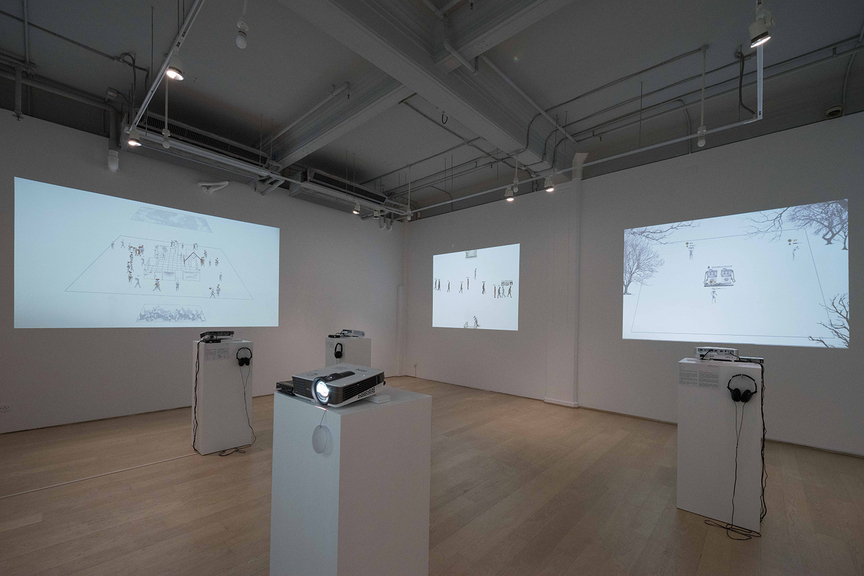-
From Current Issue
-
- Editor’s Letter Fire in the Heart
- Reviews I Gusti Ayu Kadek Murniasih
- Reviews 11th Seoul Mediacity Biennale: “One Escape at a Time”
- Dispatch Networked China
- One on One Monira Al Qadiri on Yukio Mishima
- Essays The rise of independent art spaces in pandemic-era Shanghai
- Features Tuan Andrew Nguyen
- Table of Contents
- Web Exclusives
- Archive
- Subscribe

R
E
V N
E
X
T
Physicists describe centrifugal force as fictitious. It exists only in mathematical terms, appearing to act on accelerating bodies moving in a circular path. Taking this concept as a departure point, Hanart TZ Gallery hosted “Centrifugal Force: The Art Field of Wong Chung-yu,” featuring 33 artworks created between 2003 and 2017 by Wong, including video art, installations and ink paintings. The show presented the artist’s “momentum away from the core practices of the moment and towards new trajectories of exploration,” as described by curator Valerie Doran. Wong’s diverse practice reflects the complexity of his training in art and science, as well as the complete freedom from past confines.
To attain that liberation, Wong looks inward to examine the existential void. For example, the narrative frame in one of his computer simulations, The Garden of Eden (2003), is that Eve and Adam’s children populate the world gradually, but as the population declines, the world returns to the primary uninhabited state. The work is originally run by dynamic coding in real time, so the process and its outcome are supposed to be unpredictable. However, for “Centrifugal Force,” a looped animation of previous output was on show, meant to represent the essence of the Wong’s simulation. Digital figures with their names and ages labeled above them wander, and meet a lover by sheer chance. Whenever a person dies, he or she leaves the square field and transforms into a cross in the graveyard. Others continue roaming and reproducing. Likewise, ReBond (2014) is tied closely to the idea of samsara, or the cycle of death and rebirth. In this simulation, the characters’ memories are erased before they reenter the mortal realm. The artist aims to reconstruct the existential uncertainty to express the anxiety which human beings often face in the pursuit of freedom.
WONG CHUNG-YU, Will (Number 13456), 2016, ink, color and mixed media on silk, 46 × 120 cm. Courtesy the artist and Hanart TZ Gallery, Hong Kong.
While the video simulations deconstruct linear narratives and hint at Wong’s interpretations of the circuitous nature of life and death, the artist’s ink paintings illustrate his perception of the cosmos. One of the major ink works is The Phantasm 5 (2015), a square diptych that measures almost two meters wide. Wong first used ink wash to dye the silk in multiple shades of grey, and then added details by brush. Mountains stood above all else in the composition, obscured by the murky black background. A bush of charcoal grey bamboo on the left is immerged in the slate dark rocks around it. Architectural features of an imagined cityscape—a staircase, a bridge and domes—are hidden among the textures of the mountain and waterfalls, no longer distinguishable from other elements in the surreal scene. He also explores materials such as egg shells in Will (Number 13456) (2016)—small pebble-like shells fracture in a yellow stream, whose brims are dyed jet black by ink. This marks Wong’s first forays into abstract painting, which are further demonstrated in Will (Number 6543) (2016) and Will (Number M3) (2017), two ink and color paintings on silk that measure two meters in length. In the former, ink merges with pink pigment, offset by trims of bright yellow at the center. A moon-like orb looms in peach-pink mist in the upper-right corner, above which impossible architecture rises like a faint mirage. The ink seeps down the crevices of Wong’s cliffs at the periphery, then rushes down the two-meter-long silk and halts with force in a curved stroke.
The most recent work, Will (Number M3), shows fluent alteration between the abstract and the concrete: a cluster of nearly symmetrical mountains float above an unfathomable sea of ink. Two ranges of mountains sandwich dreamy blends of salmon pink and light yellow. The dense ink eddies downward, forming vortices along the way, then halts in a U-shaped stroke pointing sharply upward. Wong emphasizes the transiting cycle between abstract and concrete forms, since both are evanescent, interrelated phases. What initially appears to be formless cannot be dismissed outright as unreal, because concrete forms can be forged when unseen elements congregate under specific circumstances. There are no universal rules to navigate such changes. The inertia of the circulation of life and death—being and nothingness—ensnares all of us, but the artist is determined to orient his artistic language with centrifugal force, steering our visions toward a new horizon.
Installation view of WONG CHUNG-YU’s “Centrifugal Force: The Art Field of Wong Chung-yu” at Hanart TZ Gallery, Hong Kong, 2017. Photo by Kitmin Lee. Courtesy Hanart TZ Gallery.
“Centrifugal Force: The Art Field of Wong Chung-yu” is on view at Hanart TZ Gallery until July 15, 2017.
To read more of ArtAsiaPacific’s articles, visit our Digital Library.









